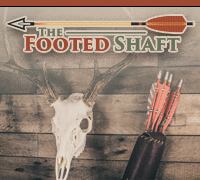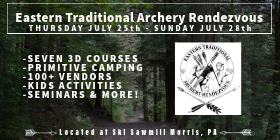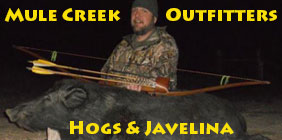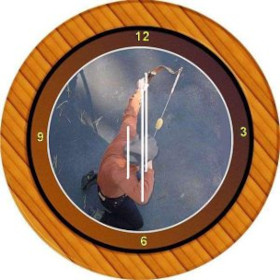Here is an article I wrote for a newsletter. Let me know what you think.
Traditional Bow Tuning – The Bare Shaft Method
by Robert Hust
4/11/08
Traditional bows can be tuned numerous ways. I prefer the bare shaft method. Several other methods may be used such as paper tuning or group tuning. My experience with the bare shaft method has proven to be a repeatable and accurate way to tune a traditional bow.
Note: Bare shaft arrows should not be used with broadheads attached while performing this tuning.
Traditional Bow Tuning
Before starting, install all accessories on the bow that will normally be used (quiver, string silencers, etc). Start by setting your brace height (the distance from the throat/deepest part of the grip to the string) to the lowest measurement recommended by the Bowyer (see illustration A). Set your nock point an inch above square. Find 6 point tipped arrows, 3 with fletching and 3 without that you think will be close in spine (refer to chart below). For example, if you are shooting a 50 lb bow drawn to 28 inches, you should start with a 1916 aluminum arrow or a 50 lb spined wood arrow. Ensure the arrows are a couple of inches longer than your actual draw length. Understand at this part of the process that accuracy is not the primary concern. The focus at this point should be on the feel and sound of the shot. You are establishing a base line of how the bow feels and sounds with the manufactures lowest recommended brace height. Start out at about 10 yards from the target. Shoot a few groups using only the fletched arrows, and note how the bow feels and sounds. Increase the brace height by shortening the string about ¼ of an inch each time. On a flemish twist this can be accomplished by twisting (tightening) the string 3 or 4 turns. With the endless loop one will have to use a shorter string to increase brace height. Shoot a couple groups again. The bow should feel and sound a little different from the previous setting. Go up to the highest recommended brace height using ¼ inch increments per adjustment. Once the entire range of adjustment has been completed pick the best brace height. You are looking for the least vibration and quietest shot (the sweet spot). Once the brace height is set we are ready to tune the arrows to the bow.
Illustration A
Arrow Length Aluminum/Wood
Bow weight at your draw 25" 26" 27" 28" 29" 30" 31"
30 lb 1616/25lb 1616/30lb 1716/35lb 1816/35lb 1816/40lb
35 lb 1616/25lb 1716/30lb 1716/35lb 1816/40lb 1816/40lb 1916/45lb
40 lb 1616/25lb 1716/30lb 1716/35lb 1816/40lb 1816/45lb 1916/50lb 1916/55lb
45 lb 1716/30lb 1716/35lb 1816/40lb 1916/45lb 1916/50lb 2016/55lb 2016/60lb
50 lb 1716/35lb 1816/40lb 1916/45lb 1916/50lb 2016/55lb 2016/60lb 2018/65lb
55 lb 1816/40lb 1916/45lb 1916/50lb 2016/55lb 2016/60lb 2018/65lb 2018/70lb
60 lb 1916/45lb 1916/50lb 2016/55lb 2016/60lb 2018/65lb 2018/70lb 2020/75lb
65 lb 1916/50lb 2016/55lb 2018/60lb 2018/65lb 2020/70lb 2020/75lb 2117/80lb
70 lb 2016/55lb 2018/60lb 2018/65lb 2020/70lb 2020/75lb 2117/80lb 2216/85lb
75 lb 2018/60lb 2018/65lb 2020/70lb 2020/75lb 2117/80lb 2216/85lb 2219/90lb
80 lb 2018/65lb 2020/70lb 2020/75lb 2117/80lb 2216/85lb 2219/90lb 2219/95lb
Arrow Tuning
In preparation for arrow tuning cover the target with a black trash bag or any dark material. In the middle of the target place a 1 inch by 1 inch piece of silver duct tape. The center of the target can be any color so long as it contrasts the darker background. The use of a darker background helps one to focus on the center of the target. Use the 3 fletched arrows and 3 bare shafted arrows from the bow tuning. Be sure the arrows have the same spine, point weight, and are all the same length. Start at 10 yards from the target. Shoot the 3 fletched and 3 bare shafted arrows at the center of the target, aiming for the 1 inch by 1 inch material. A pattern will start to appear (see illustration B). If you are getting a nock point high indication (this should be the case since we started out at 1 inch above square), start moving the nock point down a 1/16th of and inch at a time until the bare shafts are in line vertically with the fletched shafts. If you are a right hand shooter your bare shafts should be impacting to the right of the fletched shafts. Conversely, left handed shooters will be shooting to the left of the fletched shafts. Shorten all 6 arrows by a ¼ inch and re-shoot the groups again. The bare shafts should start moving toward your fletched shafts with the more length you cut off. Continue shortening all 6 arrows until the bare shafts impact the fletched shafts. If you have shortened your arrows to the point that you cannot cut any more off, move to the next stiffer arrow in the chart and start over. Another way arrows can be made to act stiffer is by reducing the point weight. To make an arrow act weaker increase the point weight. When the bare shaft and fletched arrows are grouped together, move back 5 yards and shoot another group looking for the same results (bare shafted arrows grouping with the fletched arrows). Continue to shoot the six arrow groups moving 5 yards away from the target at a time making sure the group stays together. At your maximum accurate range, verify the bare shafts are still grouping with the fletched arrows. Your bow and arrows are now tuned. Put the fletching on the 3 bare shaft arrows.
Illustration B
Results shown are for a right handed shooter. For left handed shooters, weak and stiff results will be opposite
Your arrows should be flying straight and true. Please remember the bare shaft method is only one way to tune a Traditional bow. This method has worked for me so I thought I would share the information with you. Be on the lookout for future articles.
Good luck, good shooting and most of all have fun.














